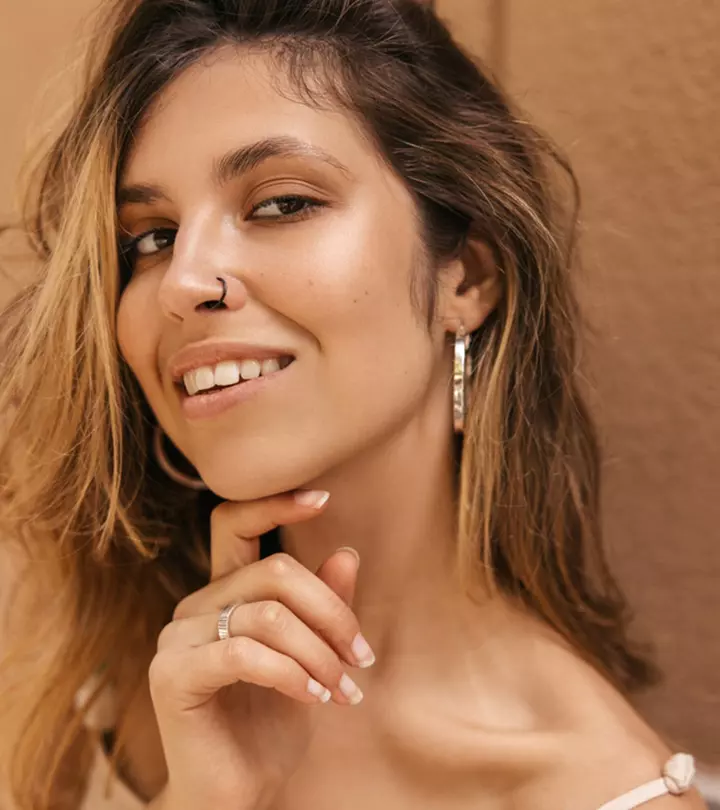How Long Does It Take For A Septum Piercing To Close?
Take care of your precious piercing to flaunt it for a long time.

Image: Shutterstock
Septum piercing has quickly gained popularity because of its edgy yet quirky look. But the biggest concern of people who have this piercing or are thinking about getting it is: do septum piercings close up? And if they do, how long does it take? This unique piercing is done on the sweet spot inside the nose, between the cartilage and the bone, that separates the two nostrils. Therefore, there are moderate chances of it closing up unexpectedly. Keep reading to find out how long it takes for this type of piercing to close and get insights on the various factors that are responsible for it. Let us dive in to learn more.
In This Article
Do Septum Piercings Close?

Like other facial piercings, septum piercings can close up if you do not let them heal properly. These piercings take about 4-6 months to heal completely, and you should wait at least a year before changing or removing the metal ring. If you remove it a few weeks or months after getting the piercing, it is bound to close up abruptly. If the piercing hole is left empty during the natural healing process, your body starts rebuilding the skin at the site of the perforation, just as it would in case of any other wound. Even if you take out the septum ring after the healing process, the chances are that the hole will shrink in size.
Mellow DeTray, a blogger, shared her failed experience with septum piercing. In her blog, she wrote, “The piercer gave me a photocopy of instructions for care, and told me I could switch out the jewelry in 4 weeks. The paper said 4-8 weeks, so I conservatively waited 5 weeks to switch from the rather large ring he used to a smaller one that I felt fitted my face more. I couldn’t get it in. Even though the new jewelry was smaller, and I had waited even longer than he had told me, my piercing was effectively gone. I cried. I went into the shop later that day; the same piercer was working. He couldn’t get it in either, and assured me that it was my fault (i).”
 Quick Tip
Quick TipSeptum piercing closure depends on when you first take out the ring after the procedure, and it may vary from person to person. Let us take a closer look at it in the following section.
Key Takeaways
- The mucus membrane in the nasal septum quickens the process of piercing closure when no septum jewelry is present.
- If the piercing shrinks, the piercer may use the tapering technique to re-open it.
- For re-piercing, the wound needs to heal completely from the outside and inside.
How Long Does It Take For A Septum Piercing To Close?
Many people come up with the following question: How long does it take for a piercing to close? While septum piercings may close up if you remove the jewelry early in the process, you do not need to worry about the piercing closing immediately. However, removing the ring immediately after getting the piercing may result in it closing up within a few minutes. It can generally vary, but a septum piercing will close up overnight if left without jewelry. It passes through a mucus membrane which tends to shut the hole relatively quicker than a regular body piercing. This is because the membrane has a faster rate of tissue regeneration and decreased inflammatory response compared to skin wounds (1).
The length of time it takes for a piercing to close depends on several factors. Some of them are discussed in the following section.
Factors Affecting Septum Piercing Closure
Several factors influence the duration of healing and closing process of your piercing. Let us discuss them below.
1. Time
The closure of a piercing is directly proportional to how long you have had the piercing. A fresh piercing will close up quickly compared to an old piercing that is in place for years.
2. Body’s Response
How fast a septum piercing closes depends on the body’s response to wound healing. Every individual reacts differently. Some people heal faster than others. Hence, the perforation may close up more quickly in some individuals. Anecdotal evidence suggests septum piercing may close up faster in healthy individuals as opposed to those with a weaker immune system or underlying medical conditions.
3. Age
Age influences the healing process in an individual. Young people have a stronger immune system and a better defense against infections (2). Whereas, older adults may experience slower healing due to reduced skin elasticity and immune function. Hence, younger individuals are likely to recuperate faster from any wound, including piercings.
4. Lifestyle Choices

The lifestyle of a person largely plays an important role in it too. A healthy diet can improve healing (3). On the other hand, smoking and nicotine consumption reduce blood flow to the piercing site, which may slow down the healing process (4).
5. Thickness Of Jewelry
The size of your septum jewelry also plays an important role in the odds of the piercing closing up. A stretched septum piercing or a thicker ring creates a larger wound, which takes a longer period of time to heal and close.
While many factors influence the closure of the septum, following certain preventive measures can help you keep it open. The next section sheds light on some of them.
How To Prevent A Septum Piercing From Closing

If you do not want your nose piercing to close up prematurely, perform the following steps.
- Clean your piercing regularly with a cotton ball and saline solution for faster healing (5).
- Avoid unnecessary touching and clean your hands with water and antibacterial soap before touching the area to keep the piercing healthy (5).
- Refrain from fiddling with your ring and try to avoid snagging it in your clothes. This will increase the overall healing time and the chances of the piercing getting rejected by the body.
- Wear hypoallergenic jewelry materials such as titanium, stainless steel, or niobium to prevent allergic reactions. You may also opt for jewelry pieces like circular barbells, captive bead rings, and septum clickers that are suitable designs for a septum piercing.
- If you plan to go jewelry-free for a while, try tapering (increasing the size of the piercing using large pins) or keep wearing the ring at regular intervals to keep the hole open.
- Wear a curved retainer to prevent the hole from closing.
 Quick Tip
Quick TipIf your piercing has closed on you even after following the preventive measures, the next subhead will guide you into the next step you need to take.
What To Do If A Septum Piercing Closes?
If your septum piercing has closed, you need to contact your piercer. It might be that your hole has started to shrink. However, do not try to force jewelry through the hole by yourself as this can damage your skin and infect the piercing. Visit your piercer to see what they can do. If your piercing was mostly healed, they may be able to stretch it gently with their tools, and you may not need to get re-pierced.
You might need to re-open the septum piercing in case it closes. In the following section, we share how that process works to put you at ease.
How To Re-Open A Septum Piercing If It Closes

At times, a piercing may appear to have closed from the outside but the hole may still be there. In such a case, a piercer uses a taper (pins to stretch the piercing to a larger size) to re-open the closed septum piercing. However, re-opening may cause the development of scar tissue in the form of a lump or bump. It may also increase the possibility of infection or complications. Always approach professional piercers for this and do not attempt the re-opening yourself.
If re-opening closed piercing is no longer possible in your case, you may need to get your septum re-pierced. The thought of re-piercing may be scary but below we have shared things you need to know before getting re-pierced.
Is It Possible To Re-Pierce A Septum Piercing?
If your septum piercing has closed up, you might need to re-pierce the area again. Consult a reputable piercer to assess the situation. They will tell you when the site will be ready for the piercing procedure again. You need to give the initial piercing time to heal completely before getting it re-pierced, which might take approximately 4 to 6 months.
When your piercer gives you the go-ahead, prepare yourself for the re-piercing. The scar tissue at the site will be thicker than the regular skin and might hurt more compared to the first time. The healing period may be the same but you need to exercise extra care of septum piercings during this period. However, if you decide to not get re-pierced, you can adorn faux septum piercing jewelry, like clip-on septum rings. They sit on your skin and give the same look as the real piercings.
A septum piercing makes for a great style statement, but it can close up if you do not take proper care of it. Although it takes 4-6 months to heal, septum piercing jewelry should be removed only after a year. Removing the piercing ring early in the healing process may cause the hole to shrink in size or close up quickly. In addition, your body’s response to wound healing, your age, lifestyle, and habits, and the size gauge of the jewelry also influence the closure of the piercing. With proper aftercare practices, you can prevent them from closing up on you.
Infographic: A Guide To Septum Piercing Closure
Septum piercings are one of the most popular trends, but like any modification, they come with their own set of unique care instructions. Whether you want to get one or you have had it for a while, healing and taking care of the piercing is just as strenuous as the procedure itself. This infographic takes you through all that would be necessary to learn about septum piercing closure and ways to prevent it. Check it out!
Illustration: StyleCraze Design Team
Frequently Asked Questions
How can I tell if my septum piercing is closing?
If you are wondering if your piercing is closing on you, check for any physical changes at the hole. If you feel it has shrunk in size or a thick skin or bump has started to grow over the opening, your nose piercing may be closing. Also, notice if you feel mild pain while wearing the jewelry.
Is it normal for a septum piercing to close during illness or infection?
Your septum piercing does not get affected when you fall sick. They are more resilient than you may think. However, if you have caught a cold, be gentle when blowing your nose and use a clean and soft tissue. In addition, keep the piercing dry and your nose clean.
If you let your septum piercing heal completely and take proper care of it, you can prevent it from closing up. The video below discusses how to clean your septum piercing. Click play to know more.
Personal Experience: Source
StyleCraze's articles are interwoven with authentic personal narratives that provide depth and resonance to our content. Below are the sources of the personal accounts referenced in this article.
(i). What I Learned About Septum Piercings From Almost Failing At It Twice
https://alifeunprocessed.blogspot.com/2018/01/what-i-learned-about-septum-piercings.html
References
Articles on StyleCraze are backed by verified information from peer-reviewed and academic research papers, reputed organizations, research institutions, and medical associations to ensure accuracy and relevance. Read our editorial policy to learn more.
- Differential apoptosis in mucosal and dermal wound healing
https://www.ncbi.nlm.nih.gov/pmc/articles/PMC4250958/ - Wound healing and aging
https://pubmed.ncbi.nlm.nih.gov/8222358/ - Nutrition and wound healing
https://www.ncbi.nlm.nih.gov/pmc/articles/PMC6429075/ - Smoking and wound healing
https://pubmed.ncbi.nlm.nih.gov/1323208/ - Suggested aftercare for body piercings
https://safepiercing.org/aftercare/
Read full bio of Anastasiia Gatsko
Read full bio of Sangita Goel
Read full bio of Subhrojyoti Mukherjee
Read full bio of Aparna Harry



























Community Experiences
Join the conversation and become a part of our empowering community! Share your stories, experiences, and insights to connect with other beauty, lifestyle, and health enthusiasts.